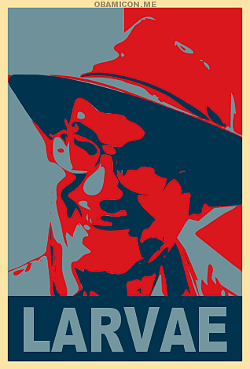SICB Annual Meeting 2010
January 3-7, 2010
Seattle, WA
Symposium: Evolutionary Paths among Developmental Possibilities: A Symposium Marking the Contributions and Influence of Richard Strathmann.

Artwork created by Karen Chan
(with apologies to Shepard Fairey)
The symposium brings together a diverse group of larval ecologists to review past research and develop new ideas that can help to explain the evolution of complex life histories. These life histories range from morphologically and ecologically distinctive planktonic larval forms to encapsulated, brooded embryos without planktonic dispersal. The symposium emphasizes data and hypotheses about marine larvae that have become a focus of conservation interest due to the potential for long-distance migration, population connectivity, and gene flow during the vulnerable larval stage. Presentations in the symposium are organized under four major areas of analysis: evolutionary constraints on adaptation of life history traits; functional constraints on life histories; maternal and environmental effects on development; and constraints or opportunities associated with larval dispersal and population connectivity.
This symposium is sponsored by DEE, DIZ (SICB) and the American Microscopical Society (AMS).
Objectives
The main objective of the symposium is to place the ecological significance of larval forms and their variety into a broader evolutionary and functional context. A specific associated objective is to contrast the view of larval stages mainly as adaptations ‘for’ dispersal or local retention with a richer view of complex life cycles as products of adaptation (including adaptation for long-distance dispersal), historical contingency, and strong environmental, developmental, and evolutionary constraints on life histories. The third objective is to recognize the contributions of Richard Strathmann in these areas of research and teaching, and to celebrate his retirement.
Organized by: Michael Hart, Molly Jacobs, Bob Podolsky

